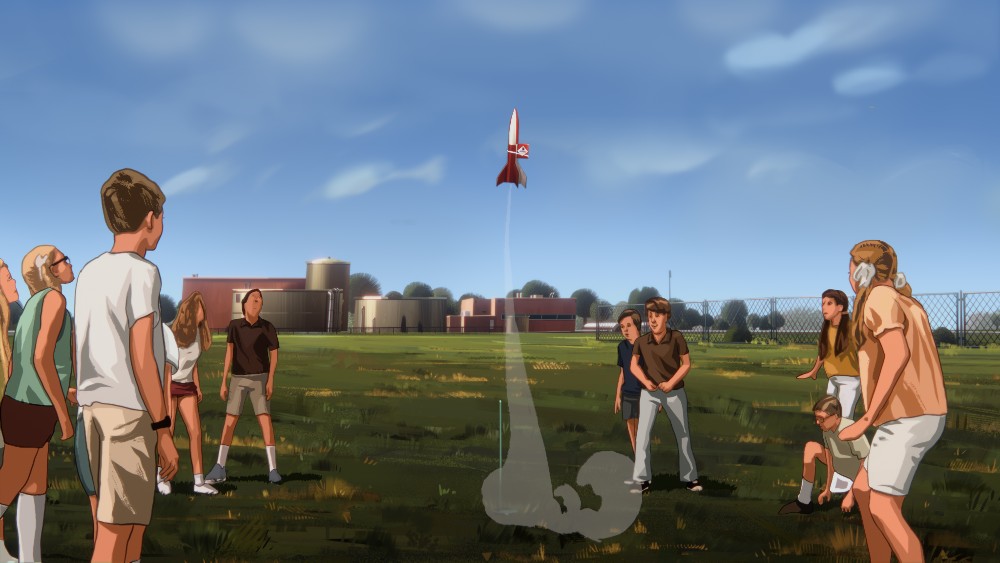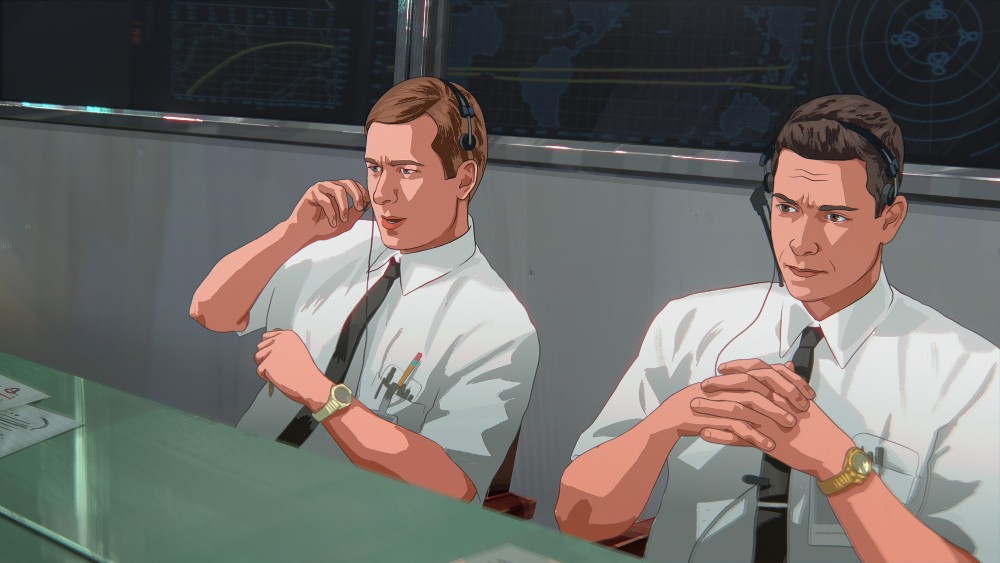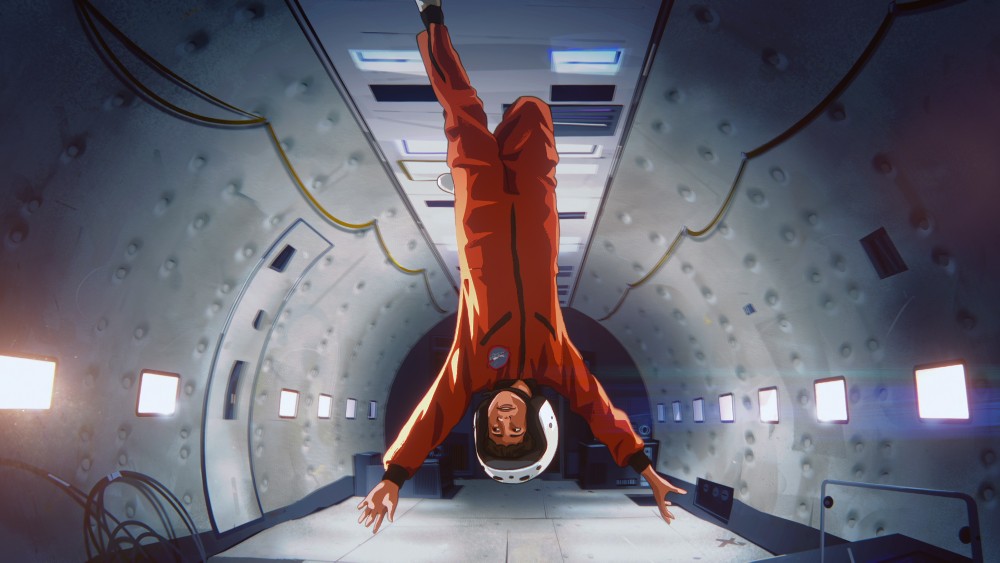Boyhood filmmaker Richard Linklater has previously explored the world of animation with 2001’s Waking Life and 2006’s A Scanner Darkly, based on the Philip K. Dick novel. His most recent animated effort, Apollo 10 1/2: A Space Age Childhood, is another one of the Oscar-nominated filmmaker’s more personal films, similar to Boyhood.
The Netflix film follows a young lad named Stan who is growing up in the Houston area in 1969 at a time when NASA was preparing to send a man to the moon. Working with longtime friend and producing partner Tommy Pallotta, Linklater created a distinctly unique-looking animated film that borrows liberally from his own childhood — although, unlike Stan, he wasn’t selected by NASA to be one of its astronauts at the age of 10.
Below the Line recently spoke with Linklater and Pallotta over Zoom, and the two filmmakers explained why animation was the only way to go when it came time to make Apollo 10 1/2: A Space Age Childhood, which is firmly in the Oscar race for Best Animated Feature.

Below the Line: This is a wonderful film, and while the moon landing stuff is great, there’s also stuff that seems very personal from your own life, which I could relate to as well. Was this something you had been taking notes on and writing for a long time before you finally committed to making it?
Richard Linklater: Technically, like [from] the second year of Boyhood. I had, that year — every year — to write a script for the next year, and I was thinking [about] first grade, third grade. That was the template for everything, and I got to second grade, and I was really examining that period, and I said, ‘We walked on the moon that year, and I was living near NASA, and I was at this elementary school, a lot of the kids’ parents [worked there], and that was actually a really interesting time and place to be a kid.’
I started thinking I’d like to do a movie about Apollo, a bottom-up version [of] what it was like to just be someone watching it on TV, or how exciting it was just to be alive right then in the culture, as a kid and all that. That’s where it started.
I started thinking, ‘Oh, that might be worthy of examining.’ I struck on this fantasy I actually had. I remember I was in first grade, so it was a couple of years before the early Apollo program. The whole movie is telescoped into this one stretch of time, but this is actually over several years, just the excitement of the whole program. That was a fantasy, when you’re in first grade and asking those annoying, “What if?” questions to your parents. “Hey, Dad, what if they built the thing, and then they needed [an astronaut]…?” I remember my dad sort of going with the story. ‘They can recruit you. They need an All-American kid.’ It was just a dumb, goofy idea, but the kind that a kid has, so that’s when I thought, ‘That idea is just ridiculous enough to be a fun, jumping-off point.’
BTL: Tommy, how long have you known Rick? You worked with him on the animation for Waking Life and A Scanner Darkly, right?
Tommy Pallotta: Yeah, I’ve worked on those, but I’ve known Rick even before Slacker. I was a PA on Slacker, and I was in it. We’ve been friends for a long time, and I produced Waking Life. In a way, Waking Life was so intimate because it was made with fewer people, and nobody knew what it was gonna be like. It sort of came out in that realm. But yeah, I love working with Rick, it’s always a pleasure.
Linklater: And likewise. We would gather and just start talking and kind of imagining things. We’re always making it up as we go, trying to achieve something conceptually that we both have imagined, and we always kind of find a way.
Tommy’s just a real pro. He knows everybody, and he knows how to get it done. We do well together. This film is very different than our other two animated films, but there are [similar] elements. It was another, “Let’s figure out how to build this machine. Let’s jump out of a plane and build a parachute on the way down.” [chuckles]
Pallotta: After Scanner Darkly, we thought, ‘There’s no reason to go back there again.’
Linklater: Yeah, we’re not doing that.
Pallotta: Going from Waking Life to that, it really [did take] a long time to just be like, ‘Okay, is it worth doing it again?’ Because animation is so hard that you probably shouldn’t do it. Whenever somebody says to me, “Hey, I want this animated,” I say, “Why?”
Linklater: Exactly.
Pallotta: Because unless you absolutely have to, then don’t animate. This story just sort of seemed like the perfect thing. A lot like Waking Life, it just sort of came together in terms of the production and how to do the animation and everything. It really felt organic and natural.

BTL: It seems odd to hear you talk about figuring things out because animation runs a wide gamut from the Pixar/DreamWorks Animation-size animation houses to people who are just doing animation at home on their computers over the course of many years. Were you already writing the script before deciding to go the animation route?
Linklater: It was this flowing idea of a story to tell, but the live-action story wasn’t working, just like the other two times [I did an] animated film. It’s kind of like what Tommy just said — “Why?” Well, because the movie doesn’t work [as] live-action. It’s a fantasy movie. This fantasy/reality is kind of a social document of the time. It’s all these things. Once you got into the memory/fantasy world of your own brain, that’s where the film really resides, and that’s where we could find the right look and textures of the memory where it sort of resides.
Once we located that, then it was like, ‘Okay, so we’re doing it this way.’ And then, it was just a matter of how. It was kind of an amalgamated mashup of styles. Tommy and I started, we were developing something for almost 10 years about two brothers that never got made, but we got a little development money and played around with it, [did] a little bit of rotoscoping, but then other techniques, too, so that was fun. And then Tommy did some projects that furthered that, so it was fun to come back together on this with just enough of a budget. I mean, we’re very much an indie-spirited, lower-budget thing, but we had just enough to do it at the level we needed to.
Pallotta: I think your question about just winging it, it kind of comes from that freedom of it not being a tentpole movie and having that really high budget, where everybody’s looking how to mitigate risk. We were able to take creative risks. We were able to go down paths that we didn’t know would bear fruit. It was a very handmade film, so there’s a lot of input from the artists that worked on it that comes through in [the film]. So you don’t want to have everything completely planned, because there are people, frankly, who can do that much better already, making [their own] movies. We wanted to do something more personal, something more handcrafted, something bespoken.
BTL: Tommy, do you have your own animation house or is there one you normally work with?
Pallotta: I work with Submarine, a production company out in the Netherlands. I’ve been working with them for about 10 years, and I work with Minnow Mountain who’s in Austin and did a lot of the rotoscoping. I’m affiliated with them. I don’t really work with anybody; I’ve tried to avoid having a company so I don’t have that burden. I can work on the things that I want to work on, when I want to work on them, with the people I want to work with at all times. One of the most difficult things is sort of carving out freedom for oneself, I think.

BTL: What’s the next step once you have the screenplay for Apollo 10 1/2? I’m not sure if you’re hiring a production designer or a DP or other department heads first, as you might with a live-action film.
Linklater: It’s such a unique production, because a production designer… yes, the film has to be conceptualized. Every shot in the movie is a special effect. Even though we’re shooting on a green screen, we’re not doing a Marvel movie. Nothing’s there, quite often — maybe a prop or whatever you’re interacting with. The good news [is that] we could start six weeks before shooting, and I would say, ‘Well, we just need to design a living room. We don’t have to actually build it.’ So we design it virtually, that’s it. We don’t have to brick and mortar it.
We could work really quickly that way, and it fit this production because that would all come later. It’s fun working with a cast — you cast, you rehearse, you have all the music picked out. It’s just like a regular movie. The final look will come later, but the essence of it is right in front of us. We just all have to [know what we’re doing]. We’re on the set, and we’re going, ‘Okay, here’s the car, and if you walk there, you’d walk through the car, you have to walk around.” It’s all kind of pre-vis’d, though I dunno. It seems like the best way. We could have all that technical complexity but still have the spontaneity of an indie film. We could still [come up with] a new idea or try things. It was kind of the best of all worlds, it felt like.
BTL: I want to make sure I have this completely clear and correct. You filmed the actors performing their parts, but that was just the basis for the artists and animators to do their work. Can you talk about that process and how it differed from your previous two animated films?
Linklater: It’s more environmental. In this case, it was really [about] the performance. [In] the previous movies, the locations were real, and everything in the shot we were shooting would be animated. In this, it was really just the performances and maybe a prop or whatever was in front of them. Everything else would be going into another 3D environment. It was just a different process.
Pallotta: It’s essentially a 2D movie, and it was 2D animated, so we used TV Paint, which is just a regular 2D animation package. We were able to do [that] with the live-action. We were able to take that reference and blend it into this animated world. In the old days or… most of the time, animators, especially 2D animators, they always have, like, a mirror by their desk, so they’re always doing that and making the faces. It’s just sort of a better form than that, and in terms of the references, the Fleischers developed rotoscoping in the early 1900s. Disney did it on all their classic hits in terms of references and things like that. It was just [like] that, but the leap we made was to not have it completely rotoscoped the way that we did with Waking Life or Scanner Darkly, but to really go back to the older methods of performance reference of the old Walt Disney and the Fleischers.

Linklater: We’re just a computer variant of them. They would project and draw.
Pallotta: But we were very careful not to… we always leaned away from the technology. Any time that we could do it, we did it hand-drawn. The only time there’s 3D is only when we had to do something in 3D. The problem with this is whenever you’re using this technology, and you’re doing something that evokes a different time, your brain has this weird disconnect between seeing something that’s super high-tech and something that’s more from a different era when it wasn’t.
We were leaning into the older animation methods, using sort of the new tools. A lot of that just means we would hand-draw stuff over… I don’t know how much you know about computer graphics, but in [the] 3D world, you have simulation, so you can put a light source and that creates the shadows. You can put, “Hey, this is hair,” and it moves the hair in a realistic way. Everything that we did, every single light streak that you see, every shadow, every single ripple in the water, was hand-drawn.
Linklater: We’re going for sort of an analog effect for an analog world, even though, obviously, everything’s ultimately digital. We wanted it to feel a little old-fashioned and [look] different, the way your brain processes your fantasies and memories.
BTL: Where does the voice recording come into play? With animation these days, the voices are often recorded in advance, so are you recording all the performances on set and then using those?
Linklater: Yeah, it’s just like we’re filming. We’re shooting scenes just like you would a regular movie. We’re just not on location; we’re on a green screen stage. We might be sitting in a real car, filming it. We’re just not actually going down a freeway or road. It’s pretty quick. We could shoot the whole film in… the production part was only 20 days. Had this been live-action, it would have been 50, probably.
BTL: The sound quality from the shoot was something you could use all the way through from beginning to end, other than Jack Black’s narration, obviously, which came later. Or did you still have to record more dialogue?
Linklater: The narration, his old Stan, that was kind of a post thing, but it was all there in the script. We knew timings and everything, so that wasn’t the hard part.
BTL: How was the editing compared to previous movies? I assume they’re animating sequences that then needed to be edited together?
Linklater: You’re editing performances, and you’re trying to tell a story, but you just don’t have it all in front of you. You’ll have, like, a drawing or a photo that represents this sequence that hasn’t happened yet. It’s like, “Well, they go into the tunnel of the Alpine Sleigh Ride. And here’s the narration, it fills up this much, but someday we will be looking at all this cool stuff. We just don’t have it yet.” And yet, we have to approximate it. You just have to imagine what it will be, but that’s how the process goes.
Even when we’re shooting, we’re imagining what the scene is going to look like, so you keep doing that until, suddenly, you don’t have to anymore. Some backgrounds come in, and then characters. The live-action green screen thing you’ve been working on gets replaced. It’s a multi-year process, but it’s really fun to see something come to life so incrementally, but so consistently. It sure takes a lot of people working full-time really hard to see that little. We’re all just working on it constantly.
Pallotta: What we did get — and I always like this before we really start production — but we started pre-production, we’re doing the design and everything, [and] by the time Rick and Zander are done editing, we really receive a radio play of the entire movie. And a radio play done really well is always very easy to imagine and visualize. Even though there wasn’t a lot of that information in there, it was very easy to visualize what could be there.
Linklater: We had a lot of historical reference, a lot of photos, and archival images. When it’s Walter Cronkite on the news, we actually had the clip. A lot of that stuff we had. [For] a lot of the NASA stuff, we had footage, so we were giving animators the clues to the look of it.

BTL: Were a lot of the animators younger, and if so, did they get all of the references, like the TV shows you used to watch after school?
Pallotta: A lot of them are a lot younger.
Linklater: Tommy’s a lot younger than me. Not a lot younger. We went to the same elementary school, but it was nine years apart or something. I was the only guy around who actually experienced [it] — I was the old guy in the room. It was so fun to see a bunch of people in their 20s and 30s who were discovering this period and really enjoying it.
Pallotta: ‘What’s a rotary phone, what’s that?’ A lot of the animators… it was during the pandemic, and they could work from anywhere. A lot of them were European, as well, so they wouldn’t even…
Linklater: They really [didn’t] understand little league baseball. We really had to explain stuff.
BTL: I had my own references, just because I was alive back then, but it’s amazing for them to be able to recreate those kinds of experiences so vividly.
Linklater: I love the way audiences reach out to whatever they’re watching and find connective tissue. That’s why we’re fascinated with other periods, because people don’t change. The backdrops [and] the cultural landscape shifts around, so you just put yourself there. Everyone has family dynamics [and] everybody grows up, so to see people find the connective tissue between now and then, or their own childhood, that’s always really fascinating and satisfying to me.
BTL: You mentioned working through the pandemic, and I’ve spoken to quite a few VFX people who were able to quickly shift to working from home when everything shut down. Where was the movie when things shut down and did it help that you were working with people overseas, so it was already partially remote?
Linklater: Our live-action part, that 20-day shoot, we wrapped about three days before the industry shut down, so our timing was… even a week later, we would have owed some shooting and had to go back and get it under crazy conditions. Our timing was really impeccable, and the editing was fairly easy. The animation, that’s different. People aren’t supposed to work at home alone. People had to work really hard and step up their communication to make that work, but I was really proud of the effort, everybody did it.
Pallotta: I think [for] everybody, it sort of seemed like an insurmountable task that… “how can you do [it] this way?” And then my mind instantly thought, ‘What are we going to lose in this process? What’s the compromise going to be?’ What was amazing is how quickly it became the norm, and how I feel like [the film] wasn’t affected at all, creatively. I think that just speaks to our adaptive powers. That’s one good thing that’s kind of cool about being human — you adapt very quickly to circumstances. What seems horrific and an existential threat today, you just have to deal with tomorrow, because you ain’t dead yet.
Linklater: That’s a metaphor for life. That’s where we were, like, ‘Well, this is our reality. How are we going to make it work for us?’ So that’s what everybody did.
Pallotta: There was nothing better than working on this film during such an uncertain time — to live in this candy-colored pop world that was sort of very innocent and wide open. I’d go out to the grocery store, and it’s all dark, and people are wearing hazmat suits. I was like, ‘I’m gonna go back to my office and work on this movie.’ [Linklater laughs at this visual]
Linklater: It was a great escape for the majority of the pandemic to be working on this, with the music, and plus, it’s a positive time. Despite the late ’60s volatility in the world, the film clusters around something that was ultimately very positive for humanity [and] the world. I would say it was the last time the world was all focused on one single achievement. It was the greatest engineering feat humanity’s ever achieved, and people were proud of it. It was something to be really, really proud of. It was very positive. There were a million ways for it to go wrong, but one way for it to go right, and damn it, they pulled it off. They were good. They worked their asses off for decades.
BTL: Also, the creativity that’s come out amid the pandemic has been incredible, not that I want to experience anything like this again in my lifetime. Since I have one question left, I’m curious about this movie you’ve been making with your pal Glen Powell, who has been having quite a year…
Linklater: Yeah, we wrapped a couple of weeks ago, I’m in post-production on that. Hitman. Wait til you see Glenn in it — it’s amazing. Yeah, it’s fun.
BTL: How has it been working under late-stage COVID protocols?
Linklater: I think we’re one of the first. Certainly, everyone tests twice a week, but we never had a COVID outbreak — we got lucky. It felt like “back to normal,” kinda, for everybody. No COVID outbreaks — everybody got through it – so it didn’t feel like such a burden anymore. I didn’t want to make a film with a mask on, and fortunately, [I] didn’t have to. My timing has been good.
Apollo 10 ½: A Space Age Childhood is now streaming on Netflix.





